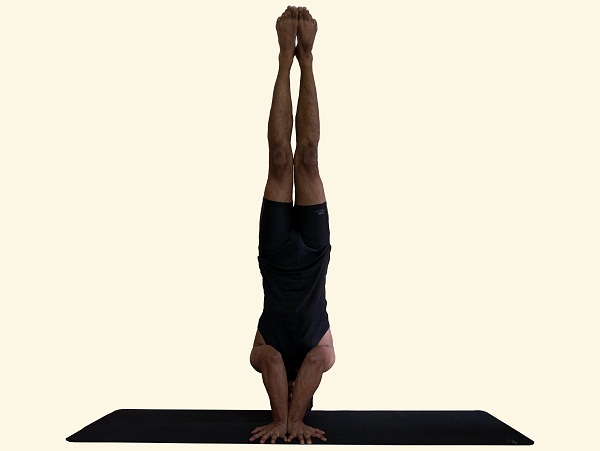This variation of Sirshasana requires more balance, so try it in front of a wall till you get the confidence to do a free headstand.

Steps:
- Kneel down and widen the knees to about one feet apart.
- Place the palms on the ground about shoulder width apart in such a way that the fingers are pointing towards you.
- Place the crown of your head at a point which is equidistant from the palms (the head and the palms should make an equilateral traiangle)
- Pressing the wrist and palms down firmly, exhale, raise the feet from the floor, lift the legs up to a vertical position and balance. Do not widen the elbow but try and bring them as close as possible.
- After learning to balance in this variation, try to bring the hands as close as possible to each other.
Benefits:
- Strengthens and aligns the spine, neck, shoulders, and arms
- Tones the legs and abdominal muscles
- Helps to prevent water retention in the legs and feet
- Increases the flow of blood to the brain giving more oxygen to the cells
- Can help to treat chronic headaches, anxiety, asthma, sinusitis, hay fever, depression, diabetes, insomnia
- Reduces symptoms of menopause
- Increases mental awareness and clarity
- Calms and soothes the mind
- Helps to re-balance sleep patterns, while decreasing memory loss
- Stimulates and strengthens the lungs, promoting healthy breathing
- Improves digestion
- Stimulates pituitary and pineal glands, which aid growth and the production of sex hormones
- Aids in the relief of tonsillitis, persistent coughing, common cold, bad breath, and palpitations
- Helps overcome problems with the liver, kidneys, stomach, intestines, and reproductive organs by reversing the pull of gravity.
Contraindications:
- High blood pressure, heart disease, thrombosis, arteriosclerosis
- Severe neck problems, like spondylitis
- During headache or migraine,
- Chronic constipation
- Kidney failure
- During pregnancy and menstruation.
- Also due to increased pressure, it is not advised if you are severely near-sighted, if you have weak blood vessels in the eye, conjunctivitis, chronic glaucoma, inflammation of the ears or any form of hemorrhage in the head.
Look for other postures in our asana directory